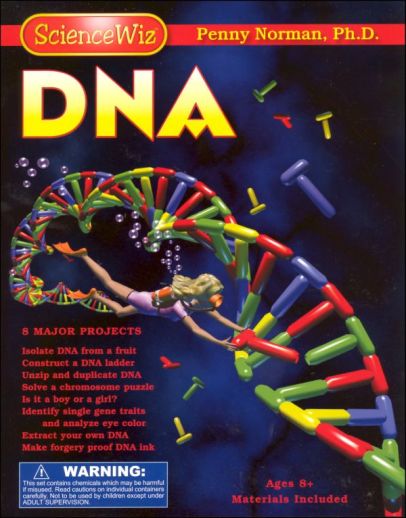We use cookies to make your experience better. To comply with the new e-Privacy directive, we need to ask for your consent to set the cookies. Learn more.
ScienceWiz DNA
A while back, Janine, Stephen and I did a science lab where we isolated onion DNA, and it was awesome - we were all in shock (first of all, that the experiment worked!), and it was incredibly cool to see the tiny strands! And then we discovered this awesome lab, which does a much better job at introducing students to DNA and really understanding it before they isolate fruit DNA - and do some very cool things with bacterial DNA! A 40-page book in the kit introduces kids to DNA and its importance. Use of diagrams and illustrations is excellent throughout the book. Then kids will jump right into extracting DNA from a kiwi, strawberry, or onion. The step-by-step instructions are both illustrated and printed, and are very easy to follow. After the dramatic results are seen, kids can observe the DNA in the test tube, and even poke it around a little bit to see what it's like. After the excitement is over, the author explains why the experiment worked, and why you can see the DNA. Now that they're hooked, students are introduced to the basics of DNA, including the four bases, the "twisted ladder" model, the history of DNA discovery, DNA duplication, how four DNA bases code for 20 amino acids, how DNA is divided into chromosomes, and more! The included equipment contains both cardstock "chromosome" halves as well as a mini-DNA model kit, so that kids can play with both of these ideas hands-on. After they have a good understanding of what DNA is and what it does, they're ready to do the last big experiment - extract their own DNA! The sample is collected from inside the cheek, and once they have isolated the DNA they can keep it in the freezer, or use it to make their own "forgery-proof" ink. This experiment takes the place of the one previously included, where young experimenters would mix plasmids into bacteria to create glowing colonies. While this is unfortunate, kids will likely enjoy isolating their own DNA as well. The lab equipment is included here; the only things you will need to supply are some household and food items. - Jess
Check out this SciencWiz Portal to Discovery for fascinating and free curriculum supplements!
Incorporate these highly educational science kits into your child's future lessons. The projects and experiments introduced in these kits cover an enormous expanse of information that will provide for a fairly in-depth study of the featured topic. These kits were designed for young children to use in a highly independent setting; parental supervision is usually kept to a bare minimum. The book is filled with vibrantly colored illustrations that provide for a pictorial guide that is easy for even the youngest of children to follow and understand. Most materials necessary for the experiments are included within the kits, although some common household materials may also be needed.~ Enh
| Product Format: | Other |
|---|---|
| Brand: | Norman and Globus |
| Grades: | 3-8 |
| ISBN: | 9781886978119 |
| EAN/UPC: | 630227078119 |
| Length in Inches: | 10.25 |
| Width in Inches: | 8.1875 |
| Height in Inches: | 1.5 |
| Weight in Pounds: | 0.85 |

